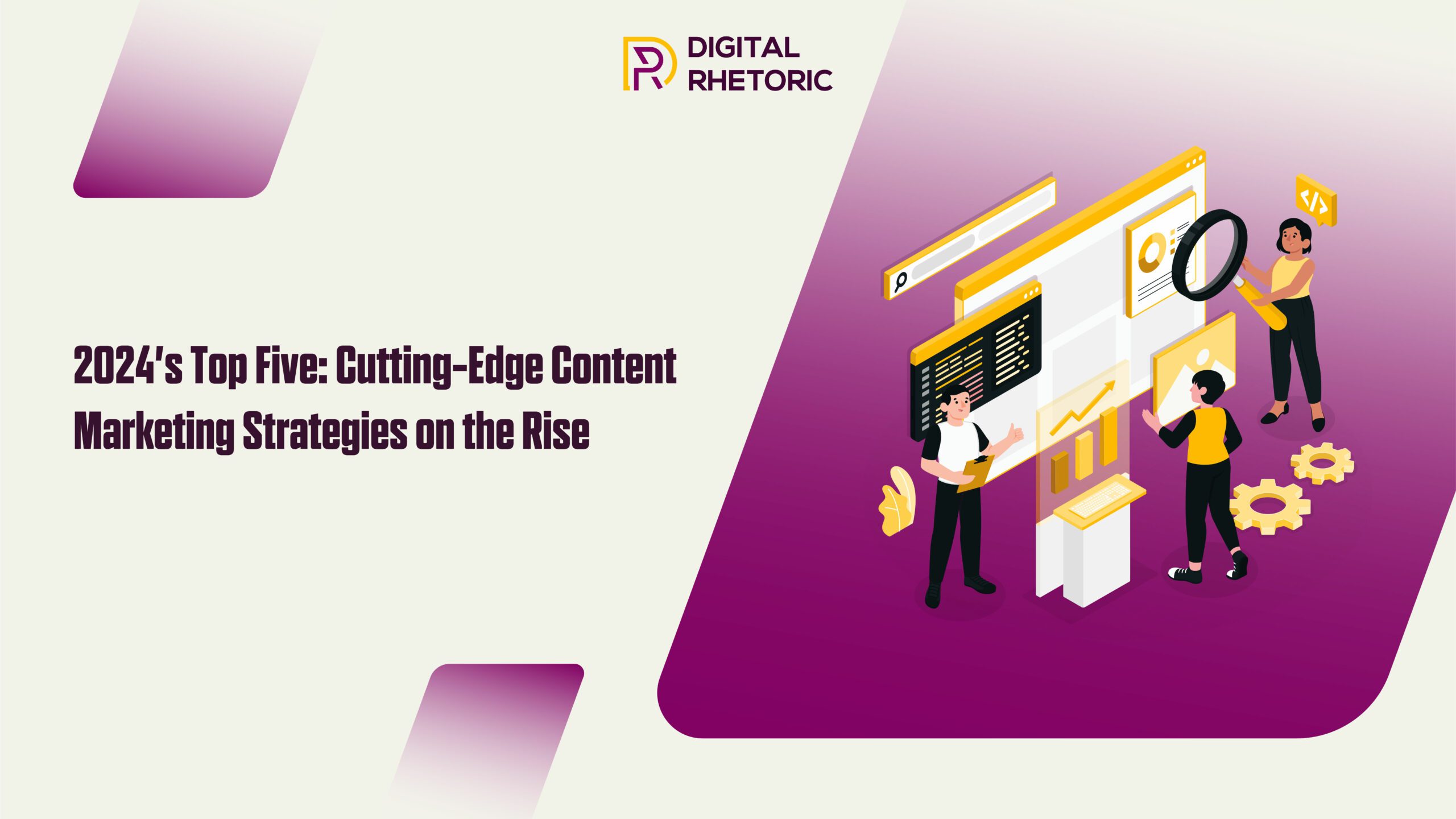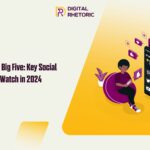2024’s Top Five: Cutting-Edge Content Marketing Strategies on the Rise
- Meenal Ghai
- January 4, 2024
- Blog, Digital Marketing
- Digital Marketing, Digital Marketing Agency, PPC Marketing Services, SEO Services, Social Media Marketing Agency, Social Media Marketing Services
- 0 Comments

In the ever-evolving landscape of content marketing, 2024 has ushered in a new era marked by groundbreaking strategies and technological advancements. At the forefront is the intentional integration of Artificial Intelligence (AI), transforming how content is created, personalized, and distributed. This year, AI’s role in content marketing has transcended from mere experimentation to becoming a core element in crafting tailored and engaging customer experiences. Moreover, the shift in search trends from traditional search engines to social media platforms, particularly among younger demographics, has redefined content discoverability and engagement. Alongside these technological shifts, the demand for video content continues to surge, expanding beyond short-form clips to longer, more immersive formats. These trends collectively signify a pivotal transformation in content marketing, emphasizing the necessity for brands to adapt, innovate, and maintain authenticity to resonate with an increasingly sophisticated and tech-savvy audience.
Intentional Use of AI
In 2024, the realm of content marketing witnessed a significant transformation, with marketers adopting a more strategic and deliberate approach to utilizing Artificial Intelligence (AI) in content creation. This trend marks a departure from mere experimentation, steering towards the strategic integration of AI to enhance content quality and relevance. Key examples illustrate this shift:
- Example 1: AI-Powered Content Optimization: Platforms like MarketMuse and SEMrush use AI to analyze existing content against competitors, providing insights to improve relevance and search engine rankings.
- Example 2: AI-Driven Content Personalization: Tools such as OneSpot and Persado use AI to tailor content to individual user preferences and behaviors, resulting in more engaging and personalized user experiences.
- Example 3: Automated Content Creation: Companies like Quill and Wordsmith employ AI to automate the creation of data-driven reports and articles, significantly increasing efficiency while maintaining high-quality standards.
These instances highlight the evolving landscape of content marketing, where AI is not just an experimental tool but a fundamental component in crafting content strategies that are both effective and relevant to target audiences.
Personalization Powered by AI
AI’s integration into content marketing has revolutionized the way businesses interact with their audience, offering highly personalized experiences. This personalization is achieved through AI’s ability to analyze vast amounts of customer data and behaviors, leading to content that resonates on a more individual level.
Some notable examples include:
- Amazon’s Customized Recommendations: Amazon uses AI to analyze past purchases, search history, and browsing behavior, providing highly personalized product recommendations to its users.
- Netflix’s Tailored Viewing Suggestions: Netflix employs AI algorithms to offer personalized show and movie recommendations based on viewing history and preferences.
- Spotify’s Discover Weekly: Spotify uses AI to curate personalized playlists, like Discover Weekly, that align with each user’s listening habits and preferences.
- HubSpot’s Content Strategy Tool: HubSpot utilizes AI to help businesses create tailored content strategies based on user interactions and preferences, enhancing engagement and conversion rates.
These examples showcase AI’s capacity to create deeply customized content experiences, from e-commerce recommendations to entertainment and digital marketing strategies. This personalization not only improves user experience but also drives better engagement, loyalty, and conversion rates.
Transparency in AI-Generated Content
The current trend in content marketing emphasizes the importance of maintaining quality and trustworthiness in AI-generated content, even in the absence of labeling requirements. This approach centers around using AI as a tool to enhance, rather than replace, human creativity and expertise. The key lies in ensuring that AI-generated content aligns with brand values, maintains authenticity, and provides real value to the audience. It’s about striking a balance between leveraging AI for efficiency and innovation, and retaining the human touch that fosters genuine connections with the audience.
Here’s a table illustrating real-life examples and the strategies they implemented:
| COMPANY/PLATFORM | STRATEGY EMPLOYED | OUTCOME |
| GPT-3 for Copywriting | Utilized for generating initial drafts, followed by human editing for tone and brand alignment. | Improved efficiency in content production while maintaining brand voice. |
| AI in Newsrooms (e.g., Reuters) | AI tools used for data analysis and initial reporting, supplemented by journalists for context and narrative. | Enhanced speed and accuracy in news reporting. |
| E-commerce Personalization (e.g., Amazon) | AI algorithms analyze user behavior to create personalized product recommendations. | Increased customer engagement and sales conversions. |
| Email Marketing (e.g., Persado) | AI-driven tools to tailor email content to individual preferences. | Higher open and click-through rates due to personalized communication. |
| Social Media Management (e.g., Buffer) | AI used for scheduling posts at optimal times and analyzing engagement data. | More effective social media strategies and better audience engagement. |
These examples demonstrate how various industries are employing AI to create valuable content while ensuring it remains authentic and resonates with their audience.
Shift of Search to Social Media Platforms
The growing preference for social media platforms like TikTok and Instagram over traditional search engines, particularly among younger audiences, is reshaping content marketing strategies. This trend is driven by the desire for more authentic and relatable content, which these platforms excel at delivering.
For instance:
- TikTok’s Educational Content: Educational institutions and educators are using TikTok to share bite-sized, engaging educational content. This approach has made learning more accessible and appealing to younger audiences.
- Instagram’s Shoppable Posts: Brands are leveraging Instagram’s shoppable posts feature to directly link products in their posts, making it easier for users to find and purchase products.
- Influencer Collaborations on Social Platforms: Many companies collaborate with influencers on platforms like TikTok and Instagram to reach younger audiences. Influencers create authentic content that resonates with their followers, effectively bridging the gap between brands and consumers.
These examples illustrate how content marketing is adapting to cater to the search habits of younger generations, emphasizing authenticity, engagement, and convenience. By optimizing content for discovery on these platforms, marketers are able to reach and engage with their target audience more effectively.
Expanding Demand for Video Content
The rise in popularity of video content, especially among digital platforms, is a significant trend in content marketing. This trend is characterized by a shift towards longer-form content in addition to the prevalent short-form videos.
For example:
- YouTube’s Enhancement Features: YouTube has long been a hub for long-form content. To improve user experience, it has introduced features like chapter segmentation and improved search within videos, making it easier for viewers to navigate and engage with longer videos.
- TikTok’s Expansion into Longer Videos: Originally known for its short-form content, TikTok is experimenting with longer video formats, allowing creators to produce more in-depth content, thereby catering to a broader range of viewer preferences.
- Instagram’s IGTV and Reels: Instagram responded to the trend by launching IGTV for longer videos and extending the duration of Reels. These features are designed to keep users engaged on the platform for longer periods.
These developments indicate a clear shift in content consumption patterns, with platforms adapting to provide more varied and in-depth video content. This trend reflects the growing appetite for more comprehensive and immersive video experiences among audiences.
Conclusion
The dynamic and ever-evolving landscape of content marketing in 2024 demands a strategic approach to leverage cutting-edge technologies and trends. From the intentional use of AI in content creation to the growing preference for video content and the shift of search habits towards social media platforms, businesses need to stay agile and innovative. To keep pace with these changes and harness the full potential of these trends, visit Digital Rhetoric for insights and strategies that can transform your content marketing efforts. Embrace the future of marketing by enhancing your strategies today – visit Digital Rhetoric and take the first step towards redefining your content marketing success.

